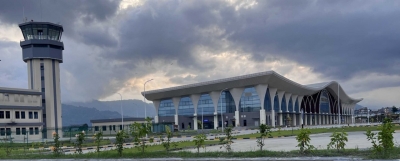Nepal: Questions raised over viability of operating flights from China-funded airport
By IANS | Updated: November 18, 2025 18:20 IST2025-11-18T18:15:43+5:302025-11-18T18:20:23+5:30
Kathmandu, Nov 18 Nearly three years since its inauguration on January 1 in 2023, the Pokhara International Airport ...

Nepal: Questions raised over viability of operating flights from China-funded airport
Kathmandu, Nov 18 Nearly three years since its inauguration on January 1 in 2023, the Pokhara International Airport in the western tourist city of Pokhara continues to struggle to attract international airlines, raising concerns that the multi-million-dollar project could prove to be a big waste of money.
Only Himalaya Airlines, a Nepal–China joint-venture airline company, has been operating a scheduled flight once a week on the Pokhara–Lhasa route since March this year.
A government-constituted high-level study committee has now identified flaws in the airport's physical and navigational design that impose load restrictions on medium-haul flights to and from the airport, raising concerns about the operational costs for airlines willing to operate regular flights through this airport.
"It has been understood that the airport requires a five per cent climb gradient for the Missed Approach Procedure Design Gradient, which is considered high for aircraft from a technical standpoint,” states the report of the High-Level Study and Recommendation Committee formed for the Reforms in the Civil Aviation Sector.
“As a result, medium-haul category jet aircraft are subject to a load penalty of four to six tonnes upon arrival, and during departure, weight restrictions also apply due to the available field length, thereby affecting the passenger and cargo-carrying capacity of the airlines," it mentioned further.
The report, produced by a committee headed by the current Minister for Industry, Commerce and Supply, Anil Kumar Sinha — who is also a retired Supreme Court judge — states that the current runway length (2500 metres) has created limitations for airline operations, particularly under conditions of high temperature, heavy aircraft weight, and/or low-pressure weather.
A senior official at the Civil Aviation Authority of Nepal (CAAN), the aviation regulator, acknowledged the report’s findings but noted that it is up to the airlines to decide how to operate their aircraft at this airport.
"It is a 4D-standard airport. Airlines have their own operational manuals, and they can operate flights here based on their own calculations regarding load penalty," Pratab Babu Tiwari, spokesperson for CAAN, told IANS. "They can assess the financial viability of operating from this airport by considering factors, including the load penalty."
A load penalty in aviation refers to a reduction in the weight an aircraft is allowed to carry — including passengers, cargo, and fuel — due to operational or safety limitations. Higher load penalties restrict the number of passengers and amount of cargo a plane can carry, affecting the profitability of airline operations.
An Instrument Landing System (ILS) has been installed at the airport with the aim of facilitating safe and successful landings even under low visibility and adverse weather conditions.
However, the report states that the system offers only limited utility due to geographical constraints. To make Pokhara International Airport more suitable for international flights, the report recommends conducting further studies as soon as possible to install advanced Performance-Based Navigation (PBN) technologies.
The release of the high-level committee’s report comes at a time when international airlines have shown little eagerness to operate regular flights to this airport, despite several incentives announced by CAAN to encourage international operations at the newly-built facility.
Despite overcrowding at Kathmandu's Tribhuvan International Airport, most international airlines have continued to avoid operating flights to Pokhara International Airport and Gautam Buddha International Airport in the southwestern city of Bhairahawa.
The airport also saw a major accident days after its inauguration. A plane belonging to Nepal’s Yeti Airlines crashed near the airport on January 15, 2023 while it was about to land, killing all 72 people on board. The ATR 72 had crashed into the Seti River gorge, just 1.5 km (0.9 miles) from the airport.
Questions about the suitability of Pokhara International Airport for medium-haul flights have arisen as Nepali politicians and bureaucrats involved in the project’s contractor selection process face corruption allegations.
In May, a sub-committee under the Public Accounts Committee of the now-dissolved House of Representatives highlighted several irregularities and corruption in the project’s construction and in the tax exemptions provided to the construction company.
Earlier in 2023, the Chinese side's characterization of the project as part of the Belt and Road Initiative (BRI) had sparked a major controversy in Nepal with the Nepali government refusing to categorise it as a BRI project and noting that construction had begun long before Kathmandu signed the Memorandum of Understanding (MoU) on the BRI in 2017.
The airport was built by China CAMC Engineering Co. Ltd at a cost of US $215.96 million, funded by China’s EXIM Bank. However, the lack of revenue generation from the project has become a major concern for the Nepali government, which must now repay the Chinese loan.
Disclaimer: This post has been auto-published from an agency feed without any modifications to the text and has not been reviewed by an editor
Open in app